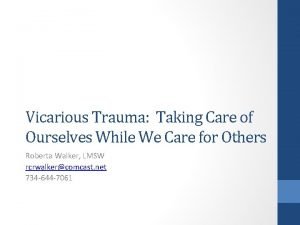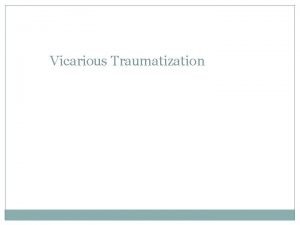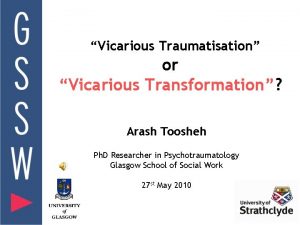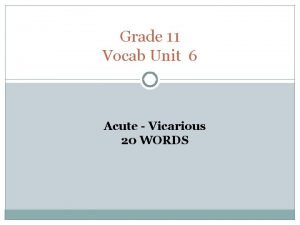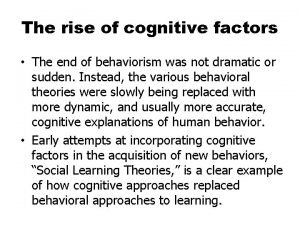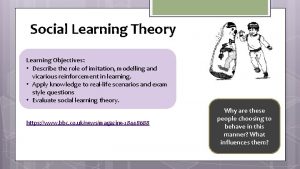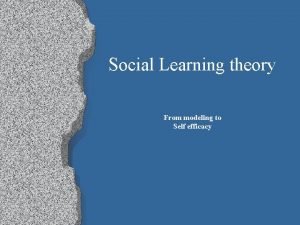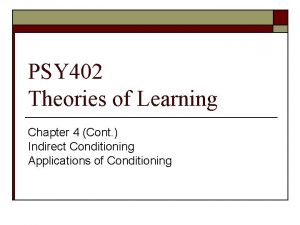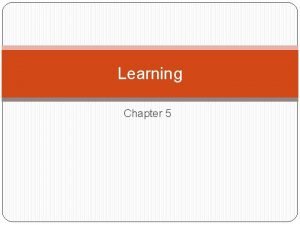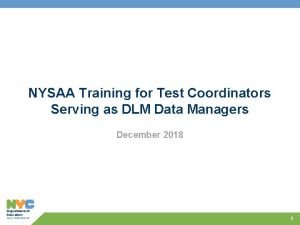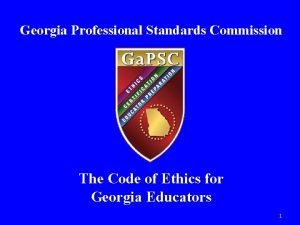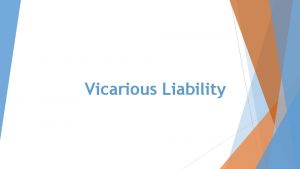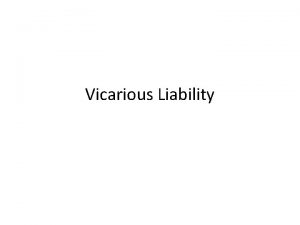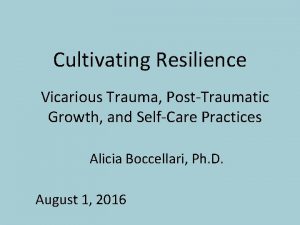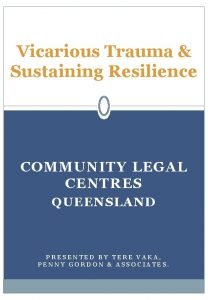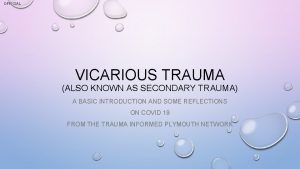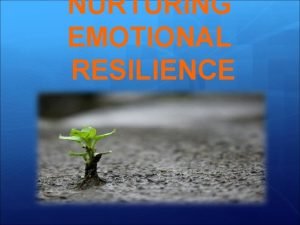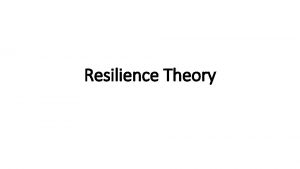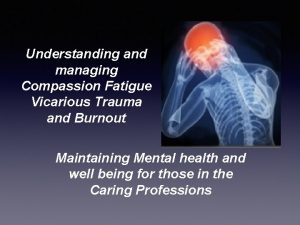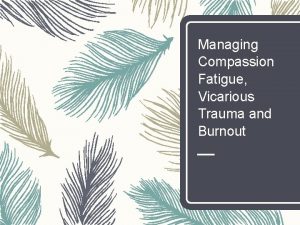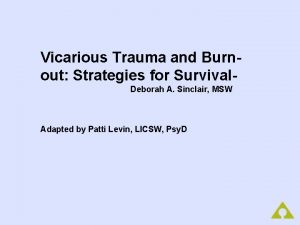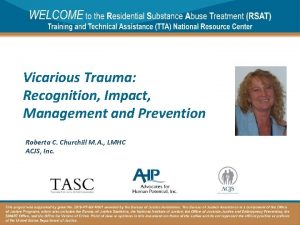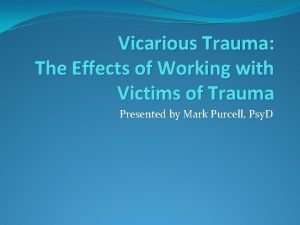Educator trauma vicarious trauma and resilience in the
















- Slides: 16

Educator trauma, vicarious trauma, and resilience in the classroom: Development of coping strategies and supports for future educators. Dr. Evonn Welton Dr. Shernavaz Vakil Dr. Lynn Kline

Current issues facing today’s educators In 2016, suicide was the second highest cause of death among children and youth and young adults aged 10 -24 (“Suicide, ” 2018). Nearly 700, 000 children are abused annually with neglect being the most frequent form of abuse. CPS protects approximately 3 million children (National Children’s Alliance, 2014) Approximately 70, 200 individuals died from overdoses in 2017. Opioid deaths have increased two fold in the last decade (Overdose Death Rates, 2019).

Current issues facing today’s educators In 2018, 15, 270 children were diagnosed with cancer in the US. (Curesearch: Number of Diagnoses, 2018). The number of children with disabilities served in public schools has increased (U. S. Department of Education, 2017). Some of these disabilities are severe and may result in death during childhood. In the 2015 -16 school year, 5. 8 percent of the nation’s 3. 8 million teachers were physically attacked by a student. Almost 10 percent were threatened with injury, according to federal education data. (Will, 2018). Cooper (2018) noted that teachers may experience verbal or physical aggression by parents or lack support and even be bullied by administrators A report in 2014 revealed that “…more than 2. 7 million children in the U. S. have an incarcerated parent. That is 1 in 28 children” (National Resource Center on Children and Families of the Incarcerated, 2014).

Current issues facing today’s educators It is only recently that society is recognizing that teaching is recognized as a highly stressful occupation teachers are significantly impacted by traumatic events that happen either to them or their students. Teachers are not only impacted by single serious events, but also the cumulative effect of on-going stressors (Minero, 2017).

What may result from exposure to traumatic events? Post-traumatic stress disorder Complex- Post traumatic stress disorder Secondary or vicarious trauma Compassion fatigue Burn-out

What may result from exposure to traumatic events? Post-traumatic stress disorder: results from direct exposure or threat of death, serious injury or sexual violation. Most often a single event. Results may include re-experiencing the event such as nightmares, attempts to avoid reminders of the event, a changed world-view, and hyper-vigilance (APA, 2013) Complex-post traumatic stress disorder: results from repeated direct exposures to traumatic events over time. Repeated abuse might come under symptoms similar to PTSD. APA has not officially included this as a disorder in the DSM and considers PTSD sufficient to address this issue. Secondary traumatic stress (Figley, 2002): Stress resulting from knowing about/observing a traumatic event happening to another. This state of tension and preoccupation with the person/situation experiencing trauma and resulting in symptoms similar to PTSD.

What may result from exposure to traumatic events? Compassion fatigue results from empathetic caring, empathetic concern, frustrations from trying to reduce the suffering but not being able to help. Persons in helping professions may experience compassion fatigue. It is a sense of helplessness and lack of support. Symptoms can include tension and preoccupation with the trauma, attempts to avoid reminders, persistent arousal, and re-experiencing traumatic events (Figley, 2002). These feelings may impact the individual’s ability to cope and function in the home and workplace (Conrad and Kellar- Guenther). In some cases, the individual may become so stressed, frustrated and unhappy, that they develop burn-out and leave the profession or simply detach to a level that negatively impacts their job performance (Figley, 2002). Diaz (2018) describes teacher burn-out as work induced depression.

Not everything is negative. Compassion satisfaction: The degree of satisfaction one feels from their job. Can mitigate satisfaction fatigue and burn-out. Is related to level of support one feels in the job setting (Conrad and Kellar. Guenther, 2006). Vicarious resilience: The ways in which trauma victims access adaptive processes and coping mechanisms to survive and even thrive (Hernandes, Gangsei, and Engstrom, 2007). The therapist, caregiver or educator can then recognize that positive strength can result form otherwise dire situations.

What can be done in the school setting for in-service educators? Prevention : Primary- Overall creation a healthy workplace environment in the school setting before stressful events can occur. Offering and communicating administrative and related services support, professional development, team building, opportunities for outside and informal social activities. Creating a positive climate for teachers and students. Secondary- District or building level analysis of events that may elicit stress in educators and systemic changes that might decrease the number or intensity of these events. RTI, professional development for teachers, counselors, principals who may be first to recognize events that are traumatic, educators who have been impacted and efforts to reduce adverse experiences. Tertiary- Supporting educators who have experienced stressful situations so the stressors are reduced and managed. EAP, working with HR. Increase support services for individual situations- perhaps an alternative classroom for a difficult student or family, paraprofessionals. Empowering teacher with effective strategies to deal with stressors. Facilitating increased resilience and satisfaction (Prevention, n. d. ).

What can be done for pre-service educators? Analyze your programs syllabi and identify specific courses that can embed issues that are known to contribute to PTSD, C-PTSD, Vicarious Trauma, Compassion Fatigue and Burn-out. Work with other programs such as general education, leadership, school counseling/school psychology, social work to enhance syllabi and course content. Consider that pre-service educators may experience trauma in field experiences or student teaching as well as after employment as in-service educators. Utilize professional development to inform other faculty and field supervisors of the potential for trauma in pre-service educators. Access university counseling center professionals for presentations to classes. .

What can be done for pre-service educators? Embed issues and possible strategies into course syllabi including but not limited to: Open and honest discussion/identification of the serious issues facing our schools todaysuicide, incarcerated parents, student aggression, difficult families, substance abuse/opioid abuse in students and parents, degenerative or terminal illnesses in children, homelessness/poverty, child abuse etc. Presentations by support services personnel- social workers, school counselors, administrators, school psychologists that offer tangible strategies for effective and preventative measures. Emphasis on effective collaboration and teams. Increase pre-service and in-service teachers’ sense of efficacy. Emphasize benefits of preventative strategies such as PBIS, RTI, IEP process etc.

What can be done for pre-service educators? Encourage reflective practice. Identify indicators of PTSD, C-PTSD, VT, CF, burn out in the educator and when/where to seek assistance. Present a balanced discussion of the impact of trauma and introduce the concept of Vicarious Resilience and Compassion Satisfaction. Encourage students to recognize that while their positive impact upon their students may not be immediately or readily observable, they may be a profoundly important person in the child/student’s life. Assist students with understanding that their professionalism, positive view of the child and hope may be profoundly impactful to the parents and their colleagues.

Courses at The University of Akron Baker (2012) found that graduate students in training for trauma therapy indicated that an entire class in vicarious trauma would benefit them. While an entire class may not be feasible for teacher preparation courses, these con 5610 467 Management Strategies in Special Education 5610 448 - Individuals with Moderate/Intensive Educational Needs: Characteristics and Implications PBIS, ABA, FBA/BIP, Crisis Prevention Training etc. are discussed. Issues such as student suicide, severe behavioral/psychiatric issues in students, students who have been abused and may demonstrate PTSD are presented. Needs of teachers are discussed including recognition of acute or chronic stress and how this might impact interaction with students and parents, teacher code of conduct, need to establish and maintain very clear professional boundaries. Videos and class discussions are used. Student presentations of a case study are presented and discussed. Legal and ethical issues of behavioral intervention are discussed. Presentations by parents who have children demonstrating intensive educational and behavioral needs. Discussions of issues facing children that may have a degenerative or terminal illness, understanding by pre-service educators that a student in their program may pass away. Ethical issues regarding students with intensive needs are discussed. 5610 439 - Collaboration with Families and Professionals in Early Childhood Agencies and related services that offer assistance to students and families, understanding that teachers also experience significant stress. *In each of these classes, time is devoted to discussion of the educators’ experiences and feelings. Team process is emphasized and validating that teachers also have a stressful reactions.

References American Psychiatric Association. (2013). Diagnostic and statistical manual of mental disorders (5 th ed. ). Arlington, VA: American Psychiatric Publishing. Baker, A. (2012). Training the resilient psychotherapist: What graduate students need to know about vicarious traumatization. Journal of Social Behavioral and Health Sciences, 6, pages 1 -2. Bernard, B. (2004). Resiliency: What we have learned. Oakland, CA: West Ed. Conrad, D. & Kellar-Guenther, Y. (2006). Compassion fatigue, burn-out, and compassion satisfaction among Colorado child protection workers. Child Abuse and Neglect, 30, 1071 -1080. Cooper, T. (2018, August). PTSD in teachers: Yes, it’s real! The Teacher’s Room: Empowering Educators as the Experts. Retrieved from: https: //theeducatorsroom. com/ptsd-in-teachers-yes-its-real/.

References Curesearch: No. of Cancer Diagnoses (2018). https: //curesearch. org/Number-of. Diagnoses. Diaz, C. (2018, August 20). The truth about teacher burnout: It’s work induced depression. American Psychological Association’s Learning Curve: Where Psychology and Education Meet. Retrieved from http: //psychlearningcurve. org/the-truth-aboutteacher-burnout/ Figley, C. R. (2002). Compassion fatigue: Psychotherapists’ chronic lack of self-care. JCLP/In Session: Psychotherapy in Practice, 58, (11) 1433 -1441. Minero, E. (2017). When students are traumatized, teachers are too. Edutopia. Retrieved from https: //www. edutopia. org/article/when-students-are-traumatizedteachers-are-too. National Children’s Alliance (2014). National Statistics on Child Abuse. Retrieved from http: //www. nationalchildrensalliance. org/media-room/nca-digital-media-kit/nationalstatistics-on-child-abuse/.

References National Resource Center on Children and Families of the Incarcerated (2014). Children and Families of the Incarcerated Fact Sheet. Retrieved from: https: //nrccfi. camden. rutgers. edu/files/nrccfi-fact-sheet 2014. pdf Overdose Death Rates (2019). Retrieved from: https: //www. drugabuse. gov/related-topics/trendsstatistics/overdose-death-rates. Prevention: Picture of America (n. d. ). Retrieved from: https: //www. cdc. gov/pictureofamerica/pdfs/picture_of_america_prevention. pdf. (Retrieved March 26, 2019). Suicide (May, 2018). Retrieved from https: //www. nimh. nih. gov/health/statistics/suicide. shtml. U. S. Department of Education. Institution for Educational Sciences, National Center for Educational Statistics (2017). Percentage distribution of students 6 to 21 years old served under Individuals with Disabilities Education Act (IDEA), Part B, by educational environment and type of disability: Selected years, fall 1989 through fall 2015. Retrieved from https: //nces. ed. gov/programs/digest/d 17/tables/dt 17_204. 60. asp? current=yes Will, M. (2018). When students assault teachers, effects can be lasting. Education Week, 37, 20, 1, 11 Retrieved from https: //www. edweek. org/ew/articles/2018/02/06/when-students-assault-teachers-effectscan-be. html.
 Vicarious felidae
Vicarious felidae Robyn bradey
Robyn bradey Vicarious trauma
Vicarious trauma Vicarius significado
Vicarius significado Vicarious transformation
Vicarious transformation Vicarious sentence
Vicarious sentence Storey v ashton
Storey v ashton What is the little albert experiment
What is the little albert experiment Vicarious liability means
Vicarious liability means Vicarious reinforcement
Vicarious reinforcement Strengths and weaknesses of social learning theory
Strengths and weaknesses of social learning theory Vicarious reinforcement
Vicarious reinforcement Vicarious reinforcement
Vicarious reinforcement Vicarious reinforcement
Vicarious reinforcement Nysaa age range chart
Nysaa age range chart Macro teaching lesson plan
Macro teaching lesson plan Georgia educator code of ethics
Georgia educator code of ethics
